
P-ISSN 1859-3585 E-ISSN 2615-9619 https://jst-haui.vn SCIENCE - TECHNOLOGY
Vol. 60 - No. 11 (Nov 2024) HaUI Journal of Science and Technology 199
SYNTHESIS OF ACTIVATED CARBON
FROM PET PLASTIC WASTE BY H
3
PO
4
ACTIVATOR
FOR ENVIRONMENTAL TREATMENT APPLICATION
CHẾ TẠO CARBON HOẠT TÍNH TỪ CHẤT THẢI NHỰA PET BẰNG CHẤT KÍCH HOẠT H3PO4
ỨNG DỤNG TRONG XỬ LÝ MÔI TRƯỜNG
Lai Thi Hoan1, Tran Van Chinh2, Le Quoc Anh3,
Nguyen Phuong Lam3, Ho Phuong Hien3, La Duc Duong2,
Tran Thuy Nga1, Nguyen Manh Ha4,*
DOI: http://doi.org/10.57001/huih5804.2024.388
ABSTRACT
The increasing environmental problems caused by plastic waste necessitate innovative waste management and resource utilizatio
n methods. This study
introduces a single-step approach to synthesizing activated carbon from Polyethylene Terephthalate (PET) plastic waste, utilizing phosphoric (H3PO4
) as the
activating agent. Optimal activation conditions of the experiment were identified with 20g PET soaked with 30mL H3PO4
and an annealing temperature of 800°C
for 60 minutes. Comprehensive characterization of the materials was conducted using SEM, XRD, BET, and FTIR techniques. The r
esulting activated carbon
exhibited a mesoporous structure with a high surface area of 655.595m2
/g. This activated carbon demonstrated a good removal efficiency for MB dye in aqueous
solutions, with a maximum adsorption capacity of 77.64mg/g. The effective conversion of plastic waste into a valuable resourc
e highlights the significance of
innovative strategies in combating environmental degradation. The synthesized activated carbon's performance in adsorption-
based remediation techniques
confirms its potential in addressing various pollution challenges, thereby offering new opportunities for the utilization of plastic waste.
Keywords: Plastic waste, activated carbon, polyethylene terephthalate, environmental treatment, chemical activation.
TÓM TẮT
Các vấn đề môi trường ngày càng gia tăng do rác thải nhựa gây ra, đòi hỏi cần phải có các phương pháp quản lý và sử dụng sáng tạo. Nghiên cứu n
ày trình
bày phương pháp đơn giản chế tạo than hoạt tính từ chất thải nhựa PET sử dụng H3PO4 làm tác nhân hoạt hóa. Điều kiện hoạt hóa tối ưu được xác định l
à: 20g
PET ngâm với 30mL H3PO4, nhiệt độ nung ở 800oC trong 60 phút. Tính chất của than hoạt tính được đánh giá bằng các kỹ thuật như SEM, XRD, BET và FT-
IR. Than
hoạt tính có cấu trúc xốp với diện tích bề mặt riêng là 655,595m2/g. Than hoạt tính có khả năng loại bỏ tốt thuốc nhuộm MB trong dung dịch với dung lư
ợng hấp
phụ cực đại là 77,64 mg/g. Việc chuyển đổi hiệu quả chất thải nhựa thành vật liệu mới làm nổi bật tầm quan trọng của các chiến lư
ợc đổi mới chống suy thoái
môi trường. Hiệu quả hấp phụ của than hoạt tính khẳng định tiềm năng ứng dụng giải quyết các thách thức ô nhiễm, từ đó mang lại cơ h
ội mới cho việc sử dụng
chất thải nhựa.
Từ khóa: Chất thải nhựa, than hoạt tính, PET, xử lý môi trường, kích hoạt hóa học.
1Department of Fundamental Science, University of Transport and Communications, Vietnam
2Institute of Chemistry and Materials, Vietnam
3Hanoi National University of Education, Vietnam
4Hanoi University of Industry, Vietnam
*Email: nmhacnh@gmail.com
Received: 08/7/2024
Revised: 30/9/2024
Accepted: 28/11/2024

CÔNG NGHỆ https://jst-haui.vn
Tạp chí Khoa học và Công nghệ Trường Đại học Công nghiệp Hà Nội Tập 60 - Số 11 (11/2024)
200
KHOA H
ỌC
P
-
ISSN 1859
-
3585
E
-
ISSN 2615
-
961
9
1. INTRODUCTION
Due to escalating environmental challenges linked to
the accumulation of plastic waste, extensive research has
focused on innovative and sustainable management
approaches. The persistence and ecological harm caused
by non-biodegradable plastic waste, such as
polyethylene (PE), polypropylene (PP), polyethylene
terephthalate (PET), and polyvinyl chloride (PVC), pose
significant concerns [1-3]. Among these, PET waste, with
its high carbon content, remains inert in the environment
for approximately 180 years, presenting a serious
environmental threat [4, 5]. Recently, value-added
recycling methods for plastic waste have gained
considerable attention. The production of activated
carbon from plastic waste offers a creative and eco-
friendly solution to the demand for versatile adsorbent
materials and the growing plastic waste problem.
Activated carbon is increasingly popular due to its high
surface area, porosity, electronic conductivity, rich and
adaptable surface chemistry, and thermal stability.
Consequently, carbon-based materials are being
progressively utilized across various sectors, including
energy, biomedical, environmental, analytical, and
electrical applications, as well as catalysis [6-8].
In numerous countries, the textile industry has
emerged as a significant economic contributor. This
expansion is accompanied by concerns regarding the
polluted wastewater generated, which contains dyes and
various pollutants that are challenging to degrade [9].
Methylene blue (MB), a commonly used dye, can cause
adverse health effects such as nausea, vomiting, anemia,
and hypertension with prolonged exposure [10]. Various
techniques are employed to treat wastewater containing
these contaminants; however, traditional adsorption
using activated carbons remains a crucial strategy due to
its effectiveness, low initial and setup costs, and reduced
operational expenses [11].
Activated carbon can be prepared through physical or
chemical activation processes. Physical activation
involves two stages: carbonization of raw materials
followed by activation using steam or CO2. In contrast,
chemical activation combines the activation and
carbonization steps into a single process. Chemical
activation offers several advantages over physical
activation, including higher yield, a one-step process, and
lower activation temperatures [12-24]. Numerous studies
have synthesized activated carbon from plastic waste
using various chemical activators, such as KOH, NaOH [4,
15]; H2SO4, H3PO4 [16, 17]; ZnCl2 [18]; and K2CO3 [19, 20].
According to the literature reports, chemical activation by
H3PO4 offers many advantages over the other methods,
including a lower activation temperature, a higher carbon
yield, and the creation of structures that are primarily
mesoporous [21, 22].
This study aimed to synthesize highly porous
activated carbon (AC) from polyethylene terephthalate
(PET) plastic using the H3PO4 - activation process. The
effects of various factors, including the PET mass ratio,
activation temperature, and activation time on the iodine
number and yield of the activated carbon, were
investigated. Additionally, the synthesized activated
carbon was evaluated for its efficacy in removing
methylene blue (MB) dye from aqueous solutions.
2. MATERIALS AND METHODS
2.1. Materials
The primary precursor for producing activated carbon
is polyethylene terephthalate (PET) derived from plastic
bottles typically used for mineral water. Following
thorough washing and oven drying, the plastic bottles
were fragmented into small particles approximately 2 -
3mm in size. Chemical reagents including H3PO4 (85%),
HCl (98%), iodine solution, sodium hydroxide, sodium
thiosulfate, and methylene blue (analytical grade) were
sourced from Xilong Chemical Company (China). Distilled
water served as the solvent throughout all experimental
procedures. All chemicals were utilized without
additional purification.
2.2. Synthesis of the activated carbon (AC)
The PET pieces were impregnated with acid H3PO4 at
a ratio of 20g:30mL. Subsequently, the PET was dried at
120oC for 12 hours, transferred to a ceramic crucible, and
heated in a furnace at various activation times and
temperatures, with a heating rate of 10oC/min under an
inert N2 flow of 100mL/min. The samples were then
washed with distilled water to a neutral environment. The
activated carbon was dried at 100°C for 8 hours, ground
for characterization, and utilized in experiments.
2.3. Determination of iodine values
The iodine number, a metric indicating the amount of
iodine adsorbed per unit mass of activated carbon
(mg/g), was used to optimize activation conditions. In a
standard procedure, 0.05g of activated carbon was
placed in separate 100 mL glass beakers, followed by the
addition of 20mL of 0.025M I2 solution to each beaker. The
mixtures were stirred for 15 minutes and then filtered

P-ISSN 1859-3585 E-ISSN 2615-9619 https://jst-haui.vn SCIENCE - TECHNOLOGY
Vol. 60 - No. 11 (Nov 2024) HaUI Journal of Science and Technology 201
using filter paper. The filtrate was titrated from orange to
pale yellow, followed by the addition of a few drops of
starch solution. Titration was continued until the solution
became colourless. The volume of 0.05M Na2S2O3 solution
used was recorded. This titration process was repeated
three times, and the average result was calculated.
The iodine number of the activated carbon sample was
determined as follow:
2
I
1 1 2 2
AC
M
Q (C .V C .V ).
m
(1)
Where Q is the iodine number (mg/g); C1 (mol/L), V1 (L)
are the initial concentration and volume of the solution,
respectively; C2 (mol/L), V2 (L) are the iodine
concentration and volume of the solution after
adsorption (L), respectively;
2
I
M
is the molecular weight of
iodine (M = 254g/mol), and mAC is the mass of activated
carbon used (g).
2.4. MB adsorption experiments
All adsorption studies were conducted in batch mode
using activated carbon (AC) as the adsorbent. A stock
solution of methylene blue (MB) was prepared by
dissolving 1g of the dye in 1L of distilled water. In a typical
experiment, 0.03g of AC was added to separate flasks
containing 10mL of MB solutions with concentrations
ranging from 30 to 100mg/L. The mixtures were shaken
at 100rpm at room temperature. Post-adsorption, the MB
solutions were centrifuged for 15 minutes at 5000rpm,
and the concentration of MB was determined using an
Agilent 8453 UV-Vis spectrometer (USA) at the maximum
absorbance wavelength (664nm). The adsorption
capacity (qe) was determined by the following equation:
0 e
e
(C C ).V
qm
(2)
where Co is the initial concentration of MB (mg/L), Ce is
the final concentration of MB (mg/L), V is the volume of
MB solution (L), and m is the mass of AC (g).
2.5. Characterization
The crystal structure of the activated carbon was
analyzed via X-ray diffraction (XRD) using a D8-Advance
diffractometer (Bruker) with a Cu Kα radiation source
(λ = 0.15405nm). The morphology and the elemental
compositions of the adsorbent were examined using
scanning electron microscopy (SEM) and energy-
dispersive X-ray spectroscopy (EDX) with a Hitachi S-4600
microscope. Fourier-transform infrared (FT-IR)
spectroscopy (Tensor II, Bruker) was employed to record
the bond vibrations within the activated carbon
structure, covering a spectral range from 400cm-1 to
4000cm-1. The surface area and porosity were determined
by nitrogen adsorption-desorption using the NOVA
Touch 2LX/Quantachrome instrument.
3. RESULTS AND DISCUSSION
3.1. Activated carbon synthesis
The effect of the activation parameters on the AC
yield, and iodine number were investigated, and the
results are presented in Table 1.
Table 1. Effect of the activation parameters on the iodine adsorption
number, and surface
Sample
Temperature,
oC
Yield
(wt. %)
Specific surface
area (m2/g)
Iodine
number
(mg/g)
AC0 400 18.09 36.559 125.27
AC6 600 14.37 138.039 335.92
AC7 700 15.72 197.118 446.43
AC8 800 13.29 655.595 965.74
AC9 900 13.99 624.308 844.21
Activation time: 60 minutes; PET:H3PO4 = 20g:30mL
Sample
Time, min.
Yield
(wt. %)
Specific surface
area (m2/g)
Iodine
number
(mg/g)
AC30 30 14.62 505,441 872.83
AC60 60 13.29 655,595 965.74
AC90 90 13.94 609,468 912.38
Activation temperature: 800 oC; PET:H3PO4 = 20g:30mL
According to the results of Table 1, the efficiency of
activated carbon recovery from PET plastic when
carbonized at 400oC is the highest at 18.09%, when
activated at temperatures from 600 - 900oC, the recovery
efficiency fluctuates, in the range of 13 - 16%. This shows
that carbonization at 400oC has not completely lost the
organic compounds in PET plastic, and this happens
when the heating temperature is raised above 600oC. The
amount of activated carbon obtained when calcined at
temperatures greater than 600oC is about 13 - 16%, due
to the amount of carbon blown away during the
calcination process and lost during the filtration process.
The porous properties of activated carbon samples
were evaluated through the specific surface area and
iodine index. It was found that for the AC0 sample, when

CÔNG NGHỆ https://jst-haui.vn
Tạp chí Khoa học và Công nghệ Trường Đại học Công nghiệp Hà Nội Tập 60 - Số 11 (11/2024)
202
KHOA H
ỌC
P
-
ISSN 1859
-
3585
E
-
ISSN 2615
-
961
9
only carbonized, the specific surface area and iodine
index were the lowest, respectively 36.559m2/g and
125.27mg/g respectively. When activated by H3PO4 at
temperatures above 600oC, the specific surface area and
iodine index of the samples increased significantly,
gradually increasing with increasing calcination
temperature. Thus, the carbonization process simply
causes the loss of organic compounds in PET plastic.
When activated with H3PO4, it develops porous channels
on the surface of the carbon, leading to an increase in the
specific surface area and adsorption index I2. At a
calcination temperature of 800oC, the specific surface
area and iodine adsorption index are the highest at
655.595m2/g and 965.74mg/g, respectively; These values
decrease when increasing the calcination temperature to
900oC to 624.308m2/g and 844.21mg/g, respectively. At a
temperature of 800oC, the pore system is most complete.
At 900oC, it begins to transit to the ashing stage and the
capillaries break down, so the specific surface area and
adsorption index I2 have decrease. Thus, we choose the
optimal calcination temperature of 800oC.
It is seen that, in Table 1, when activated for 30
minutes, the activated carbon sample only has a specific
surface area and an iodine index of 505.441m2/g and
872.83mg/g. During this time, the capillary system is
gradually being completed and when activated for 60
minutes, the activated carbon capillary system is most
complete with a specific surface area of 655.595m2/g and
an iodine index 965.74mg/g. When increasing the
activation time to 90 minutes, there was a slight decrease
in the porosity of activated carbon. Thus, we choose the
optimal calcination time of 60 minutes.
3.2. Characterization of activated carbon
Figure 1. SEM of the activated carbon
The surface morphology of activated carbon
synthesized under optimal conditions (activation time: 60
minutes; activation temperature: 800oC) was
characterized by scanning electron microscopy (SEM). As
shown in Fig. 1, the produced activated carbon structure
has many grooves and pores, showing that the activated
carbon surface is a porous capillary system developed.
For low-resolution SEM images, we observe granules and
fragments of activated carbon, and for high-resolution
SEM images, we see that the surface of activated carbon
is quite smooth. These observations indicate that the
activating agent reacted progressively with the material,
affecting not only the surface but also penetrating the
inner parts of the carbon material.
Information about the structure of activated carbon
was analyzed by X-ray diffraction method, the result is
shown in Fig. 2a. On the XRD pattern, peaks appear at
position 2θ = 14.84o; 22.76o corresponds to the (110) and
(120) faces, which characterize the carbon phase with
hexagonal structure (standard card 00-050-0926) and the
peaks at 2θ = 26.42o; 42.36o; 54.51o corresponds to the
(002), (100) and (004) faces that characterize the
hexagonal structure graphite phase (standard card 00-
008-0415). After that, the diffraction peaks are weak.
Gradually, because the structure of activated carbon is
graphite, there are many defects on the wall, leading to a
decrease in graphite crystallization of activated carbon.
The desired activation process creates many defects on
the carbon wall to increase the surface area of activated
carbon to facilitate the adsorption process. In this case,
the diffraction peak of activated carbon made from PET
plastic is relatively weak, proving that the surface area of
activated carbon is quite good. The XRD pattern with few
peaks and disorder also shows that the active carbon is
amorphous.

P-ISSN 1859-3585 E-ISSN 2615-9619 https://jst-haui.vn SCIENCE - TECHNOLOGY
Vol. 60 - No. 11 (Nov 2024) HaUI Journal of Science and Technology 203
Figure 2. XRD pattern (a), FT-IR spectra (b), N2 adsorption-desorption
isotherm (c), and EDX spectra of activated carbon
According to Fig. 2a, the wave number at position
3445cm-1 characterizes the vibration of the –OH
functional group. The spectral fringe vibrating around
1562cm-1 characterizes the C=C bond, and at 1128cm-1
there is the appearance of the C-O stretching vibration.
The resultant activated carbon's surface may have these
functional groups, which could provide it an effective
adsorption affinity for organic molecules.
As seen in Fig. 2c, the adsorption-desorption isotherm
curve shape of activated carbon is of type II according to
IUPAC's classification, which is a material with large
capillaries (macroporous) and has a hysteresis loop of
type H3, which is a flexible sheet-shaped material [23].
The specific surface area, capillary diameter and capillary
volume of activated carbon are 655.595m2/g, 3.389nm
and 0.120cm3/g, respectively.
Table 2 shows a comparison of the porous properties
of prepared activated carbon with some other studies.
Energy-dispersive X-ray spectroscopy (EDX) was used
to analyze the elemental composition of the activated
carbon. The resulting figure (Fig. 2d) displays the
distinctive peaks of C, O, and P. The appearance of C
comes from the original PET plastic material. The
activator, H3PO4 acid, is responsible for P and O's
appearance. The findings of the EDX analysis
demonstrated the acid H3PO4's activation ability and
validated the elements present in the first material that
was anticipated to be produced.
3.3. MB adsorption study
3.3.1. Adsorption isotherm
To determine the adsorption capacity of prepared-
activated carbon, the adsorption isotherm has been
investigated to collect the adsorption equilibrium. The
adsorption isotherm of MB on the AC was investigated by
mixing the adsorbent with 10mL of MB solutions for 60
minutes at room temperature in which the MB
concentration varied from 30 to 50mg/L at pH 7,
adsorbent mass of 0.03g.
Adsorption isotherms for MB using activated carbon
as adsorbents were investigated by the Langmuir and
Freundlich models. The obtained data were fitted with
the following equations:
e e
e m L m
C C
1
q q .K q
(3)
e F e
1
logq logK .logC
n
(4)
where qe (mg/g), qm (mg/g), Ce (mg/L), KL (L/mg) are
the equilibrium adsorption capacity, the maximum
capacity, the equilibrium MB concentration, and
Langmuir constant, respectively. KF (L/g) is the Freundlich
constant and n is the heterogeneity factor.
The curve intercept provides the Langmuir constant
(KL), which represents the binding centers' affinity. The
separation factor (RL) provides the characteristic of


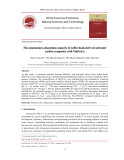
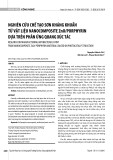
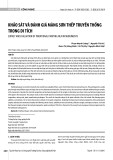
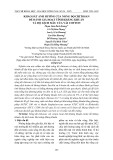

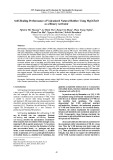
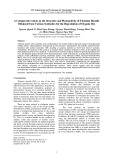

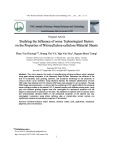

![Tài liệu Vi sinh vật môi trường [Mới nhất]](https://cdn.tailieu.vn/images/document/thumbnail/2025/20251123/ngkimxuyen/135x160/21891763953413.jpg)
![Sổ tay truyền thông Phân loại chất thải rắn sinh hoạt trên địa bàn tỉnh Quảng Nam [Chuẩn nhất]](https://cdn.tailieu.vn/images/document/thumbnail/2025/20251114/kimphuong1001/135x160/1701763094001.jpg)


![Quản lý chất thải nguy hại: Sổ tay Môi trường [Chuẩn nhất]](https://cdn.tailieu.vn/images/document/thumbnail/2025/20251029/kimphuong1001/135x160/9011761720170.jpg)









